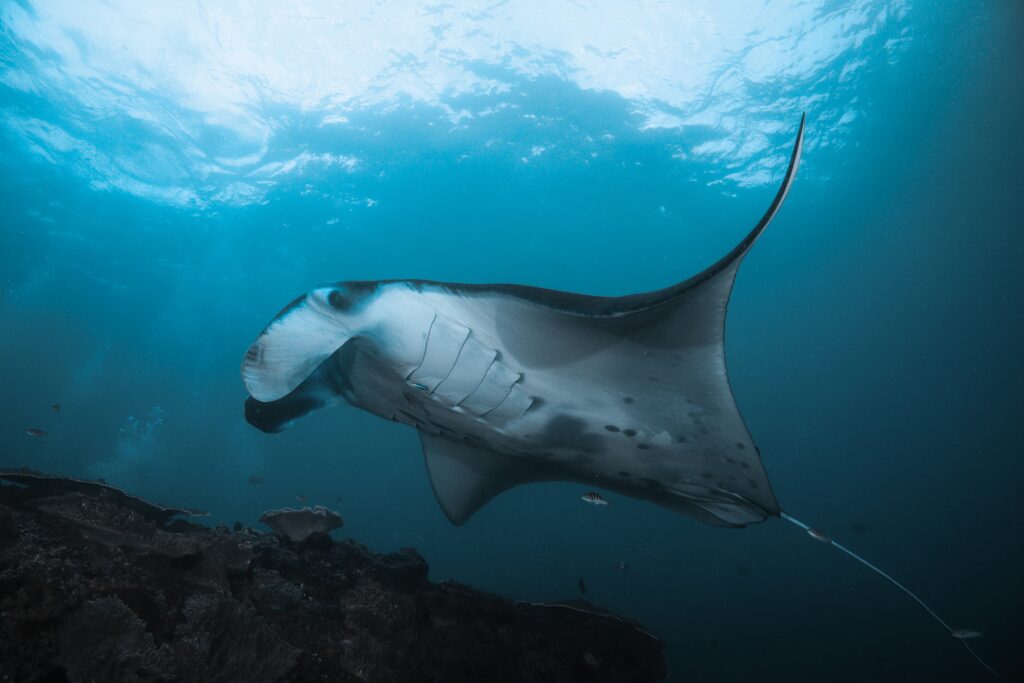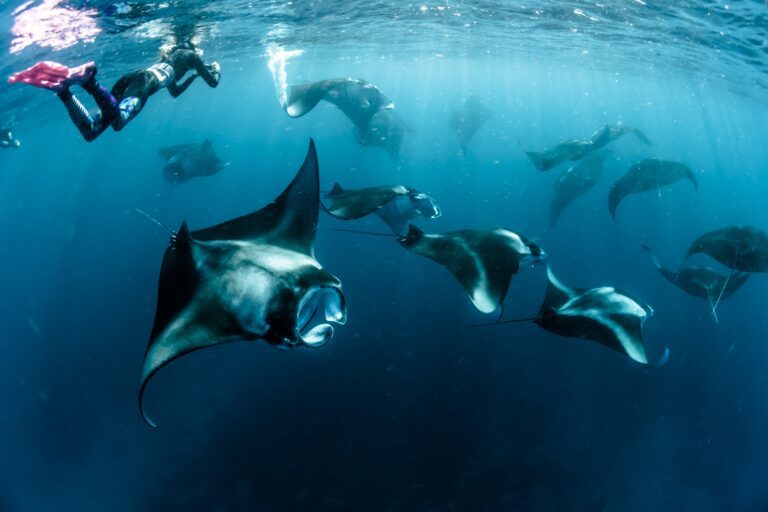The ocean, an expanse covering more than 70% of our planet’s surface, is a realm of countless wonders and enigmatic creatures. Among these marine marvels, the manta ray stands out as a captivating and mysterious species. Often referred to as the “gentle giants of the sea,” these magnificent creatures have long intrigued scientists, divers, and nature enthusiasts. In this comprehensive article, we will take a deep dive into the world of manta rays, unraveling their unique characteristics, behaviors, and will be Exploring the Mysteries of Manta Rays and the Manta Tornado.
A Glimpse into the World of Manta Rays and the Manta Tornado
Manta rays are captivating creatures, and to understand them better, it’s essential to explore their taxonomy and classification. These majestic animals belong to the family Mobulidae, falling under the order Myliobatiformes. Within this family, two recognized species exist: Manta birostris, known as the giant oceanic manta ray, and Manta alfredi, the reef manta ray. These two species exhibit notable differences in size, habitat, and behavior, providing valuable insights into the diversity within the manta ray family. National Geographic covers manta rays in depth but little is known about the manta tornado.
Manta rays are renowned for their sheer size and distinctive appearance. With wingspans reaching up to an astonishing 23 feet (7 meters) or more, they are among the largest species of rays in the world. Their coloration is equally striking, featuring a predominantly black or dark gray dorsal surface and a white ventral side. This unique coloration pattern not only adds to their allure but also aids in camouflage, helping them blend seamlessly into their underwater environment.
One of the most distinguishing features of manta rays is the presence of cephalic lobes. These cephalic lobes extend forward from their heads, resembling a pair of wings. This feature gives manta rays their iconic appearance and serves a fascinating purpose in their daily lives.

Feeding Habits of Manta Tornados
Manta rays are known as filter feeders, and their feeding habits are nothing short of extraordinary. Their mastery of filtration sets them apart in the underwater world. These gentle giants primarily feed on plankton and small fish, and their feeding technique is a marvel of evolution.
To capture their prey, manta rays employ their cephalic lobes as efficient filter-feeding mechanisms. They gracefully funnel water into their mouths, where specialized filtering pads trap their minuscule prey. This elegant and efficient feeding behavior is akin to underwater ballet, as they glide through the water with their mouths wide open, almost resembling avian acrobats as they skim the ocean’s surface.
When part of a manta tornado it is estimated that 30 – 50 mantas feeding together can filter over 1 million gallons of water every 20 minutes!
Distribution and Habitat Preferences
Understanding the distribution and habitat preferences of manta rays provides valuable insights into their ecological niche. Manta rays are found in tropical and subtropical oceans around the world, predominantly favoring warm waters. However, their choice of habitat is not indiscriminate; they exhibit specific preferences based on factors such as food availability and temperature.
These magnificent creatures are not confined to a single ocean but are encountered in various oceanic regions globally. They tend to frequent specific habitats, including coral reefs, cleaning stations, and underwater pinnacles. These habitats offer them both sustenance and shelter, making them ideal locations for observing these gentle giants in their natural environment.
The Extraordinary Behavior of Manta Rays
Beyond their physical attributes, manta rays are renowned for their mesmerizing and enigmatic behaviors. Two behaviors, in particular, capture the imagination of those fortunate enough to observe them up close: breaching and barrel rolling and of course as part of a manta tornado.

Acrobatic Displays: Breaching and Barrel Rolling
Breaching is a behavior that distinguishes manta rays and adds an element of mystique to their underwater world. These gentle giants are known for their occasional acrobatic leaps out of the water. The exact purpose of this behavior remains a subject of scientific intrigue. While some speculate that it may serve a communicative or navigational purpose, others suggest it could be a means of dislodging parasites or simply a display of vitality.
Barrel rolling is another captivating behavior exhibited by manta rays. During this behavior, they execute graceful rolls, often while being cleaned at cleaning stations. This rolling motion may help them rid themselves of parasites or facilitate communication with other mantas. Regardless of its precise purpose, observing manta rays engage in barrel rolls is a mesmerizing experience that adds to their allure.
Manta Ray Intelligence
Recent studies have shed light on the intelligence of manta rays, challenging traditional perceptions of rays as simple, instinct-driven creatures. These studies have highlighted the complexity of their brain structure, indicating that manta rays possess relatively larger brains relative to their body mass compared to most other fish species. This suggests a higher level of cognitive function than previously recognized.
Experiments have further demonstrated their problem-solving abilities, showcasing their capacity for learning and adaptability. Such cognitive skills are increasingly acknowledged as vital components of their survival in complex marine ecosystems.
Manta Tornado: Unraveling the Phenomenon
The enigmatic “Manta Tornado” is a mesmerizing natural spectacle that has puzzled scientists and captivated the imagination of marine enthusiasts worldwide. This phenomenon involves a large group of manta rays congregating and swimming together in a spiral-like formation, creating a visual spectacle like no other.
Defining the Manta Tornado
The term “Manta Tornado” aptly describes this awe-inspiring phenomenon. It refers to the remarkable sight of numerous manta rays coming together and swimming in a coordinated, circular manner. This behavior often occurs periodically at specific locations across the globe, attracting divers and researchers eager to witness this breathtaking display.
Theories and Explanations
The Manta Tornado remains a subject of scientific fascination, with various theories attempting to explain this captivating behavior:
- Feeding Frenzy: Some experts speculate that the Manta Tornado may be a result of coordinated feeding. In this scenario, mantas congregate to exploit an abundant source of planktonic prey. The swirling motion created by their coordinated swimming could concentrate plankton and make it easier for them to feed.
- Mating Behavior: Another theory suggests that the Manta Tornado might be linked to mating rituals or courtship displays. This theory proposes that this coordinated swimming could be a means of attracting potential mates or establishing dominance within the group.
- Social Interaction: The Manta Tornado might also serve as an opportunity for social interaction among these intelligent creatures. Mantas are known to have complex social lives, and this behavior could play a role in reinforcing social bonds or hierarchies within their groups.
Research and Conservation Impact
The study of the Manta Tornado has significant implications for both scientific understanding and conservation efforts:
- Scientific Significance: Research into the Manta Tornado provides valuable insights into the behavior, ecology, and social dynamics of manta rays. It offers a rare glimpse into their complex lives and interactions.
- Ecotourism and Conservation: The presence of the Manta Tornado often draws ecotourism, which can have both positive and negative impacts on manta ray populations. Proper management and responsible tourism practices are essential to ensure the well-being of these magnificent creatures.
Ecotourism and Responsible Interaction
The rise of manta ray tourism has brought economic benefits to many coastal communities. However, it also comes with challenges that must be addressed responsibly to protect manta ray
UP NEXT
8 Destinations to swim with Manta Rays
Swimming Feather Stars and Other Strange Ocean Creatures
10 Fascinating Seahorse Species and Where to Find Them



